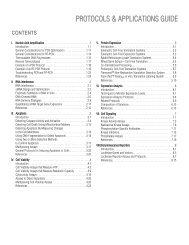2012 Promega catalogue
2012 Promega catalogue
2012 Promega catalogue
You also want an ePaper? Increase the reach of your titles
YUMPU automatically turns print PDFs into web optimized ePapers that Google loves.
Cell Signaling<br />
Cell-Based Proteasome-Glo Assays<br />
Product Size Cat.# Price ($)<br />
Proteasome-Glo Chymotrypsin-Like Cell-<br />
10 ml G8660 751.00<br />
Based Assay<br />
5 × 10 ml G8661 Pls. Enq.<br />
2 × 50 ml G8662 Pls. Enq.<br />
Proteasome-Glo Trypsin-Like Cell-Based<br />
10 ml G8760 751.00<br />
Assay<br />
5 × 10 ml G8761 Pls. Enq.<br />
Proteasome-Glo Caspase-Like Cell-Based 10 ml G8860 751.00<br />
Assay<br />
5 × 10 ml G8861 Pls. Enq.<br />
Proteasome-Glo 3-Substrate Cell-Based Assay 10 ml G1180 1741.00<br />
System<br />
For Laboratory Use.<br />
50 ml G1200 Pls. Enq.<br />
Description: The Proteasome-Glo Cell-Based Assays are homogeneous,<br />
luminescent assays that individually measure the chymotrypsin-like, trypsin-like<br />
and caspase-like protease activities associated with the proteasome complex in<br />
cultured cells. The 26S proteasome is a 2.5MDa multiprotein complex found in<br />
all eukaryotic cells. Proteasome-Glo Cell-Based Assays provide luminogenic<br />
proteasome substrates in buffers optimized for cell permeabilization,<br />
proteasome activity and luciferase activity. Addition of the Proteasome-Glo<br />
Cell-Based Reagent in an “add-mix-measure” format results in proteasome<br />
cleavage of the substrate and rapid generation of a luminescent signal<br />
produced by the luciferase reaction.<br />
The three luminogenic substrates used to monitor specific protease activities<br />
include: Suc-LLVY-aminoluciferin for chymotrypsin-like, Z-LRR-aminoluciferin<br />
for trypsin-like, and Z-nLPnLD-aminoluciferin for caspase-like activity. Each<br />
luminogenic substrate is added to a buffer system optimized for its specific<br />
proteasome activity and luciferase activity. The reagents are added to cells in<br />
culture, and the proteasome cleaves the substrates, releasing luciferin, which<br />
is consumed by luciferase, producing “glow-type” luminescence correlating to<br />
enzyme activity or inhibition.<br />
The Proteasome-Glo Cell-Based 3-Substrate System consists of three<br />
homogeneous bioluminescent assays that measure the three proteolytic<br />
activities associated with the proteasome in a cell-based format (each of these<br />
three assays also is available separately).<br />
The Proteasome-Glo 3-Substrate System consists of three<br />
homogeneous bioluminescent assays in an enzyme-based format (each of<br />
these three assays also is available separately).<br />
Features:<br />
• More Biologically Relevant Results: Obtain activity data directly from a<br />
cellular environment with the Proteasome-Glo Cell-Based Assay.<br />
• Simplified Method: The “add-mix-measure” protocol minimizes handling<br />
steps and makes the assays amenable to automation.<br />
• Faster Results: Maximum sensitivity is reached 10–30 minutes after<br />
reagent addition.<br />
• Greater Sensitivity: The luminescent assay format avoids inherent<br />
fluorescent background signals, providing excellent signal-to-background<br />
readings. The assays are miniaturizable to 384-well format.<br />
Storage Conditions: Store the Proteasome-Glo Assay components at<br />
–20°C.<br />
Protocol Part#<br />
Proteasome-Glo Chymotrypsin-Like, Trypsin-Like and Caspase-<br />
Like Cell-Based Assays Technical Bulletin<br />
TB346<br />
Proteasome<br />
For complete and up-to-date product information visit: www.promega.com/catalog<br />
H<br />
Suc-LLVY – N<br />
or<br />
Z-LRR –<br />
or<br />
Z-nLPnLD –<br />
S<br />
N<br />
Suc-LLVY + H2N or<br />
S N COOH<br />
Z-LRR<br />
or<br />
Z-nLPnLD<br />
N S<br />
Aminoluciferin<br />
Ultra-Glo rLuciferase<br />
Light<br />
N<br />
S<br />
COOH<br />
ATP, Mg ++ , O 2<br />
The luminogenic substrates containing the Suc-LLVY, Z-LRR or<br />
ZnLPnLD sequence are recognized by the 20S proteasome. Following<br />
cleavage by the 20S proteasome, the substrate for luciferase (aminoluciferin)<br />
is released, allowing the luciferase reaction to produce light.<br />
Signal-to-Noise Ratio<br />
100,000<br />
10,000<br />
1,000<br />
100<br />
10<br />
Suc-LLVY-Glo Substrate<br />
Z-LRR-Glo Substrate<br />
Z-nLPnLD-Glo Substrate<br />
Suc-LLVY-AMC<br />
Suc-LLVY-AMC+SDS<br />
Boc-LRR-AMC<br />
Ac-nLPnLD-AMC<br />
1<br />
0.00001 0.0001 0.001 0.01 0.1<br />
20S (µg/ml)<br />
Luminescent proteasome assays are more sensitive than fluorescent<br />
proteasome assays.<br />
1<br />
10<br />
5855MA<br />
5994MB<br />
143<br />
6<br />
Drug Discovery<br />
Section<br />
Contents<br />
Table of<br />
Contents
















